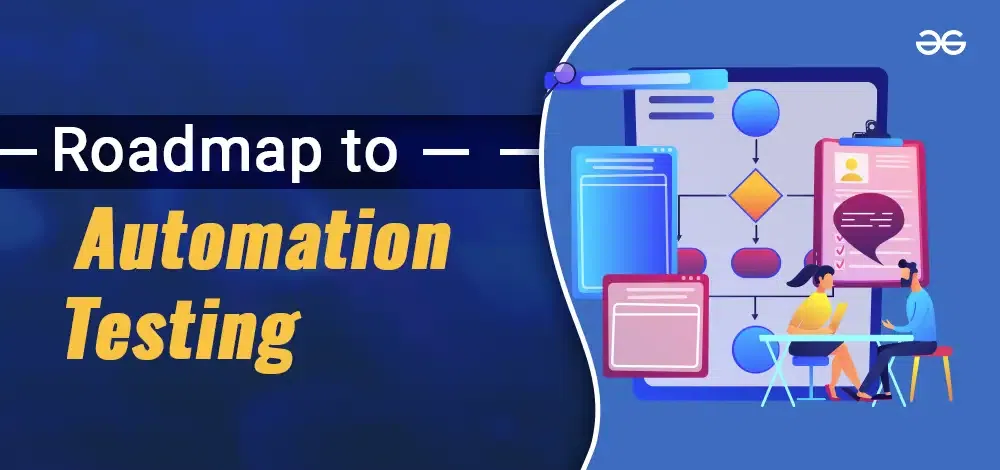Test automation has become a vital aspect of the Software Development Life Cycle (SDLC), aimed at reducing the need for manual effort in routine and repetitive tasks. Although manual testing is crucial for ensuring the quality of a software product, test automation plays a significant role as well.
By effectively implementing test automation, software testers can focus on exploratory and functional testing, ultimately improving the overall quality of the software. For those interested in pursuing a career as a test automation engineer, let’s explore a roadmap to success.
Table of Content
What is Automation Testing?
Automation testing is a software testing technique that uses specialized tools and scripts to automate the execution of predetermined test cases and verify the behavior and performance of software applications. The goal of automation testing is to increase efficiency, reduce testing time, and enhance the overall quality of the software. Automation testing simulates a set of scripts or test scenarios and compares the actual outputs with the expected outputs, preparing a detailed report.
It is particularly useful in repetitive and time-consuming tasks which allow for faster and more frequent testing in the context of continuous integration, and continuous development (CI/CD) pipelines. It is specifically used in regression testing to compare whether the new code disrupts the functionality. It is important to understand that we cannot automate the whole process of testing. Wherever human intuition is required, such as exploratory testing or functional testing, manual testing will be used. A balanced approach combining both manual and automated testing can be used to ensure the quality of the software.
Looking to master software testing and automation? Our comprehensive guide course: “Complete Guide to Software Testing and Automation: Master Java, Selenium, and Cucumber”, provides you with the skills needed to excel in the field. Whether you’re a beginner or an experienced tester, this course will help you take your career to the next level.
Manual Testing vs Automation Testing: Overview
Manual Testing relies on a human tester to execute test cases; therefore, it is suitable for exploratory or usability testing. Manual testing is cost-effective for smaller projects and initial testing phases. In automation testing, we use tools and scripts that can perform repetitive tasks efficiently. Automation testing is generally used in large-scale projects; it is crucial in regression testing or load testing. It is integrated into continuous integration pipelines for quicker feedback during the development stages. Choosing manual or testing depends on the nature of the project, cost considerations, and how much testing coverage is desired. Often, a mixture of both manual testing and automation testing is used, which leads to better software testing.
| Parameters | Manual Testing | Automation Testing |
|---|---|---|
| Definition | Manual testers manually execute test cases without any automation tool or script. They execute predetermined test cases step-by-step to find defects. | Automation testers use automation tools or scripts to execute test cases. They compare the actual output with the desired output to find defects. |
| Processing time | Manual testing is time consuming. | Automation testing is faster than manual testing. |
| Resources required | Manual testing takes up human resources. | Automation testing takes up automation tools and trained employees. |
| Exploratory Testing | Exploratory testing is possible in manual testing, allowing to adapt testing based on observation and intuition. | Exploratory testing is not possible in automation testing. |
| Performance testing | Performance testing is not possible with manual testing. | Performance testing like load testing, stress testing, spike testing, etc is possible in automation testing. |
| Framework requirement | Manual testing does not involve the use of any automation frameworks or scripts. | Automation testing involves the use of automation frameworks to execute test cases. |
| Reliability | Manual testing is less reliable due to likelihood of human errors. | Automated testing is more reliable due to the use of automated tools and scripts. |
| Investment | Manual testing relies on humans therefore lower initial costs but can be time consuming and costly for large projects. | Automation testing demands higher initial investment but offers speed and efficiency for large projects. |
Roadmap To Automation Testing
1. Basics of Testing
- Cover the foundational points of Software Testing by using books such as “Agile Testing“. Learn about the testing principles, methodology, and best industry practices.
- Add on to your theoretical understanding by doing practical exercises and apply the concepts learned in real-world scenarios.
- You can use online platforms such as GeeksForGeeks to access resources related to automation testing and gain insights from it.
2. Learn the Basics of Programming
- Start your programming journey by learning user-friendly languages such as Python or JavaScript. Later on, you can move to more complex languages like C++ or Java. You can practice those languages on GFG interactive coding platforms, where you can run your code.
- Apply your programming skills to create basic automation scripts, which will lay a solid foundation for the complex tasks ahead.
- To increase your confidence in coding, you can do hands-on coding projects, which will establish your fundamentals for upcoming advanced testing topics.
3. Select an Automation Tool and Technology
- Choose a particular domain and stick to it, whether it is web development or mobile application development. Align your learning according to the complex details of the chosen domain.
- You can master an automation tool like Selenium for web applications or Appium for mobile applications through online tutorials and personal projects.
- Explore the details of the tools, such as Selenium and Appium, and gain a deep understanding of their functionalities and applications.
4. Build Test Automation Frameworks
- Increase your expertise by understanding the complexities of the software test automation frameworks, the architecture, and the design principles that govern these frameworks.
- Apply your knowledge to create personalized automation frameworks using the tools you have learned and your selected programming languages.
- Explore additional frameworks, such as TestNG or JUnit for Java, that are going to increase your skill set and ability to deal with diverse testing challenges.
5. Integration with Version Control and CI/CD
- Exploit the power of version control systems with a dedicated focus on mastering Git. Learn more about the details of branching strategies and understand how you can optimize versioning for collaborative development.
- Integrate your automation scripts into a Git repository, ensuring not only version control but also the structure of a collaborative and organized development environment. This will enhance the team’s efficiency and ensure a smooth workflow.
- To gain a deeper understanding of continuous integration (CI) concepts, explore tools like Jenkins. Understand how CI can easily integrate automated tests into the development pipeline, which will provide rapid feedback on the code changes. The Continuous integration will promote continuous improvement and early detection of potential issues.
6. Advanced Topics and Continuous Learning
- Explore advanced testing concepts such as behavior-driven development (BDD). Enhance your testing toolkit by including innovative methods that focus on aligning business goals with test practices.
- Become proficient in a particular testing domain, such as performance testing or API testing. Understand the complex details that are involved in assessing an application’s performance and ensuring its functionality in an API-driven environment.
- Show your zeal for growth by continuing to learn and staying aware of new industry trends and tools. You can do so by participating in online communities and pursuing relevant certifications. These will ensure your skills remain current and adaptable to the changing domain of software testing.
Transition from Manual to Automation Testing
You may be in manual testing and want to switch to automation testing or you might already be in an automation profile but want to add to your automation skill-set. Now the first step in making the switch is to find the right automation tool based on your skill-set and interests.
- Select an automation tool: You should make the choice of your automation tools based on these factors.
- Domain: Depending on which domain you have expertise in, testing regularly is going to affect your choice of automation tool. For example, if you perform functional testing for websites, go for web UI automation tools like Selenium, QTP, etc. For mobile applications, you can select Appium or Robotium.
- Programming experience: Opt for the tools, keeping in mind your comfort in the programming language. Select those tools that are supported by your language of choice.
- Paid or Free: Some of the automation tools are open-source and free, whereas others are paid. Depending on your investment and goals, you can select a paid or free automation tool.
- Resources for Learning: Once you have selected your tool, find online and offline resources for learning the tool.
- Hands-on with the tool: Practice each command and feature of the tool by coding parallelly.
- Test real projects: Get a hold of a framework or sample script of real applications in testing and run sample scripts on those.
Conclusion
Making the switch from manual to automated testing is a wise professional step, as the need for automated testing in the software development industry keeps growing. Automating repeated tasks guarantees faster and more effective testing procedures in addition to streamlining repetitive tasks. A successful shift requires the integration of frameworks, automation technologies, and continual learning. Software quality is maximized when human and automated testing methods are balanced, opening the door to a thorough and successful testing plan. A successful and fulfilling career in test automation can be achieved by embracing the path to automation success, learning programming, becoming an expert with automation technologies, and adapting to changes in the software testing industry.
FAQs
Why is Automation Testing important?
Automation testing is crucial because it reduces manual efforts on repetitive tasks, increases efficiency, and improves software quality by allowing testers to focus more on exploratory and functional testing.
Differentiate between Automation testing and Manual testing in terms of processing time.
Automation testing is faster than manual testing as it uses scripts and automation tools, making it suitable for large-scale projects and integration into CI pipelines for quick feedback.
Can we perform Exploratory testing in Automation testing?
No, exploratory testing requires human intuition, which is not possible in automation testing. Manual testing is better suited for exploratory or usability testing.
Why is a balanced approach of Manual and Automation testing recommended?
A balanced approach ensures the whole testing coverage of the product,combining the strengths of both manual and automated testing. Automation testing is efficient for repetitive tasks; manual testing brings human intuition to exploratory testing; and functional testing enhances software quality.
How can one switch from a Manual to an Automation testing role?
One should follow a roadmap,including mastering the basics of testing,learning a programming language, selecting automation tools,building test automation frameworks, integrating with version control and CI/CD, and exploring advanced topics. Domain expertise and programming experience are crucial in selecting the automation tool.





